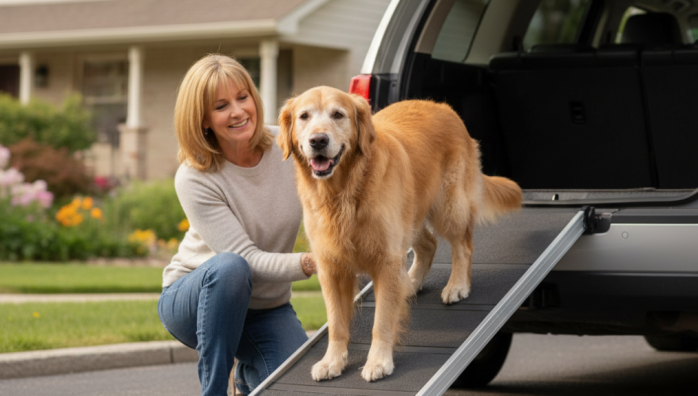Supporting Senior Dog Mobility with Ramps
by admin in Pet Care Basics 2 - Last Update November 14, 2025

Watching my old friend start to slow down was one of the hardest parts of our journey together. I remember the exact moment it hit me. He’d always launched himself onto the sofa with a happy wiggle, but one evening, he just stood there, looked at the cushion, then looked at me with confused eyes. He tried a little hop and failed. My heart just sank. That hesitation, that look of frustration on his face—it was a clear sign that our daily routines needed to change to support his aging body.
When I first noticed the struggle
It wasn't just the sofa. Getting into the car for our weekend adventures became a chore instead of a joy. I’d have to lift his back end, and I could tell it was uncomfortable for him. I started seeing other subtle signs, too: stiffness after a nap, a reluctance to use the stairs, and a general loss of that youthful spring in his step. It's a quiet change, and if you’re not looking for it, you might miss it at first. For me, it was a wake-up call that I needed to be more proactive about protecting his joints.
Why jumping is a bigger deal than it looks
I used to think jumping was just a natural dog thing, but I’ve learned so much over the years. For a senior dog, especially one with a touch of arthritis or joint dysplasia, every single jump puts a huge amount of impact force on their hips, shoulders, and spine. Think about the jolt of landing. Over time, that repeated stress can accelerate joint degeneration and cause significant pain. Preventing those high-impact movements became my top priority. It wasn’t about stopping him from living his life; it was about helping him live it more comfortably.
My journey into the world of dog ramps
Honestly, my first thought was just to lift him everywhere, but at over 70 pounds, that wasn't a sustainable solution for my back or his dignity. I started looking into mobility aids and discovered dog ramps. At first, I was skeptical. Would he even use it? Was it just another piece of gear to clutter up the house? But the more I read, the more I realized it was a simple, effective tool to give him back his independence and protect his body.
Key features I learned to look for
Choosing the right ramp was a bit of a process. Through some trial and error, I found a few non-negotiable features that made all the difference:
- A non-slip surface: This is the most important thing. I looked for something with a high-traction material, like textured carpet or a rubbery surface, so he’d feel secure with every step.
- A gentle incline: A ramp that’s too steep is just as bad as a jump. I made sure to measure the height of my car and sofa to get a ramp long enough to create a gentle, easy slope.
- Sturdiness and weight capacity: No wobbling allowed! A stable ramp gave him the confidence to use it. I checked that the weight limit was well above his actual weight.
- Portability: For the car, I needed something that could fold up easily and wasn't too heavy for me to handle on my own.
Teaching an old dog a new trick: ramp training
I didn't just put the ramp down and expect him to use it. We made a game out of it. I started by laying the ramp flat on the floor and luring him across it with high-value treats. We did this for a few days until he was walking over it without a second thought. Then, I propped it up on a low step, and we practiced again. Slowly, we worked our way up to the full height of the sofa and then the car. Lots of praise, lots of patience, and lots of his favorite snacks made the process positive and stress-free. In less than a week, he was using it like a pro.
The difference it made for us
The change was incredible. Seeing him walk confidently up the ramp into the car, ready for an adventure, was everything. He was no longer hesitant or dependent on me to get to his favorite snoozing spot on the couch. It was more than just a piece of equipment; it was a tool that restored his confidence and my peace of mind. It’s a simple adjustment, but one that has profoundly improved his quality of life in his golden years. Of course, this is what worked for my best friend, and I always recommend chatting with your vet to create the best mobility plan for your own senior dog's specific needs.









